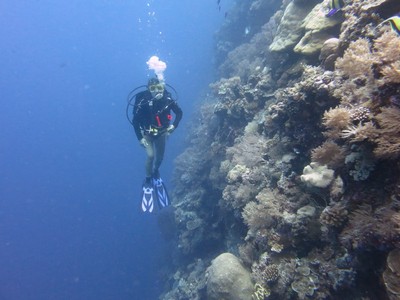
Below are the best of the photos from our reef diving. Most of them were taken by my husband Dave.
The signature dive for Palau is Blue Corner, which is just one spot on the reef. But in reality, there are about 5 miles of reef on the SW side of the Palau archipelago that have just incredible diving. Incredible because of the clarity of the water and the huge amount of fish life--caused by a combination of current outside the reef and environments conducive to marine hatcheries inside the reef... and stringent protection regulations.






The people who manage diving tourism in Palau have done a great job of making the dive sites accessible without damaging the reef. They have a string of dive buoys all along the reef.




Besides the SW reef area, there are several channel dives. These are drift dives in the channel, usually on the incoming current. The best one is Ulong Channel, and we have done this several times. During May and June the Grouper are spawning, and they are all over in Ulong Channel. Other popular channel dives are German Channel and Lighthouse Channel.
For a few dives, Jerry from Challenger volunteered to be "dinghy tender". This was quite a luxury for us. Makes things much easier on current dives to know there is someone on the surface following your bubbles, no matter where you end up.

On other dives, we towed the dinghies with us. This is possible when there are no other divers or dive boats to worry about, and when there's not much wind.



There were lots of other very cool things to see in Ulong Channel, but it all happens pretty fast as we are drifting along at 1-2 knots. I really like the garden eels, but they are very hard to get a picture of. They are only about 8-10" long and sink into their holes in the sand when you approach. They look like turtle grass unless you look carefully.
Near Ulong Channel is a very nice no-current reef dive called Coral Gardens. This is a great place to take a novice diver as it is shallow and easy, with lots of pretty fish and coral.

Further out from Ulong Channel is Saies Tunnels and Saies Corner. It's a long dinghy ride (3-4 miles), but doable in our RIBs with 15-25 HP motors. In the early morning (half tide or greater to get over the reef) with no wind, it's an exhilarating ride. And totally worth it.





The only problem with all this "resource management" is that it ends up being very expensive to cruise here. The $120 you pay on arrival as a cruiser is just the beginning. To go and anchor ANYWHERE except the single designated cruiser anchorage at Sam's Tours, it costs $50 per month for a Cruising Permit for the boat, and $50 per person for a 10-day Rock Islands permit.
So the first excursion out to the Rock Islands costs a whopping $150 for 10 days, and another $100 for another 10 days. Plus, there has been almost no wind (good for diving, bad for sailing), and so we've had to motor everywhere, and diesel is $5.45/gallon.
But it's better than paying the fly-in tourist diver rate of $145 per diver per day for a two-tank dive (plus of course, hotel, meals and transportation).
In my next installment, I'll post some pics of the wrecks we have seen.
No comments:
Post a Comment